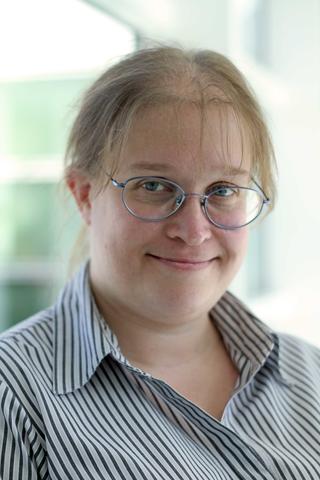
My name is Louise Wright, I’m a 44 year old woman, and I’m the Science Area Leader for modelling at the National Physical Laboratory (NPL). I’ve been using finite element analysis (FEA) and similar techniques for about 20 years across a wide range of applications, with an emphasis on problem solving for scientists and engineers. After doing GCSEs at a comprehensive and A levels at an FE college, I studied maths at Cambridge. In my second and third years I had summer jobs working for a firm that made fibres for clothing and for filters. I helped develop software that modelled one of their spinning processes (simulating mass flow and heat transport), and did some research into journal bearing models to identify the cause of a problem with one of their pumps. These jobs made me realise that maths could be used to solve real-world problems in an industrial environment. I looked at courses that could help me take this further and chose an MSc in Mathematical Modelling and Numerical Analysis. Following this I decided to get a job rather than doing a PhD because I like having a variety of problems to work on, and spent a year modelling vehicle impact tests at the Transport Research Laboratory using FEA. Whilst this was exciting in some ways, the work was less varied than I’d hoped. I then moved to the R&D wing of a firm that made roof tiles. Initially I was working on the use of genetic algorithms (GA) for design of roof tiles. The main challenge for a tile is that it has to be strong to survive roofers standing on it during fitting but it has to be light to save on material costs and on roof loading, so the challenge (as in many design problems) is one of maximum strength, minimum weight. The use of a GA to solve this problem led to interestingly “organic” looking designs that a human designer would be unlikely to produce. During my time there I also used FE for modelling firing of clay tiles (differential thermal expansion is a big problem at certain temperatures), computational fluid dynamics for air flow within concrete tile dryers, and designed simple spreadsheet models for clay tile drying, as well as spending time inside an actual dryer in a factory in Italy to collect the measurements necessary to test the model. My final project was on coatings, which literally involved watching paint dry. After three years at the roof tile firm, I joined NPL and have worked there ever since (almost 18 years now). NPL is the UK’s National Measurement Institute (most other countries have an equivalent), responsible for realising and disseminating the measurement standards for the UK. We measure quantities key to industry, such as mass, length temperature and material properties, and we measure quantities such as electrical power, gas concentration, ultrasound intensity, and ionising radiation dose that support quality of life. Pretty much all of the work we do has a mathematical model involved somewhere along the line, and as a result I get a fascinating range of problems to work on. I help people design equipment, I help them interpret their results when they don’t look the way they’d expected, and I help them find ways to apply existing measurement techniques to new problems. Because we measure a huge range of quantities, I work on a wide variety of physics problems and am always learning something new. Uncertainty quantification is at the heart of measurement science as it enables two measurements to be compared, and so makes international mutual recognition of measurement capability, which is essential for international trade, possible. My group works on uncertainty evaluation techniques to enable this process within the laboratory and for external parties. We are also starting to apply our experience to the large-scale problems that sensor networks, satellite images, and medical imaging modalities generate so that decision making in those areas takes uncertainty into account. I’d always known I was good at maths, but until I had the summer jobs at university I hadn’t realised what a huge range of jobs require maths skills. If you’d asked me what a mathematical job was I’d’ve answered accountancy, academia, banking or insurance, and I knew I didn’t want to do any of those. I thought I’d have to train in physics or engineering to get to solve real world problems, but that’s not the case. Everything from flight scheduling to building bridges uses maths, and I’d advise anyone just starting who knows they’re good at maths to look beyond the usual to get inspiration.
